Abstract
Flash floods are considered one of the most devastating and frequent extreme climatological natural hazards in the world. El Minya is one of the most vulnerable areas in Egypt for flash flood problems. It was affected by several hazardous historical flash flood events. These events could lead to both catastrophic losses of life and severe damage to the infrastructures of the study area. The study area is located in the middle of Egypt, about 240 km south of Cairo. It is situated along the Limestone Plateau facing El Minia governorate. The main objective of this study is to assess the risk of flash flood hazard on the human activities in the study area. Integration of remote sensing; geographic information systems, analytical hierarchy process, and the multi-criteria decision analysis (MCDA) techniques were applied in this study. Eight different significant effective factors collected from multisource geospatial data, including lithology, hydrology, topography, soil type, land cover, and rainfall data, were selected to evaluate the flood risk map. Remote sensing imagery was used for land use/cover mapping to detect the vulnerable human activities. ArcGIS-based weighted overlay modeling was used to combine the criteria to calculate the final decision map.
1. Introduction
Flash floods are one of the most devastating natural disasters in the world, causing damage to properties, killing more than 5000 people every year, and registering the highest mortality rate among the other riverine and coastal flooding disasters [1].
Egypt is considered one of the countries that suffer from flash flood hazards and risk in mountains and nearby areas; every year, people, human activities, urbanized areas, and infrastructure are threatened by rainwater inundation. In the last few years, Egypt has experienced several flash flood events that caused serious damage and loss of lives, infrastructures, and buildings. The analysis of historical flash flood events over Egyptian land indicates that the eastern desert received highly destructive repetitive flash flood events starting in 1979 along El-Quseir and Marsa Alam, which killed 19 people and destroyed the coastal highway. The flash flood of Marsa Alam city, which happened in 1991 and caused big damage, the Alexandria city flash flood that killed 21 people in 1993, as well as a well-known flash flood that happened in 1994 and caused severe damage to infrastructure and loss of lives in Assiut governorate [2].
In October 2016, a devastating flash flood event struck Ras-Gharib city, killed dozens, and caused damage to infrastructure [3]. The Minya area has been affected by several flash flood events since 1975; heavy rainfall happened in Upper Egypt. It destroyed about 180 houses and displaced 1500 citizens [4]. In November 1997, a flash flood affected the area of study and killed 53 people, destroying 260 houses [4]. Recently, in March 2020, a heavy-rainfall flash flood struck the area, causing land subsidence and huge damage to the El Geish highway, infrastructure, and settlements as shown in Figure 1.
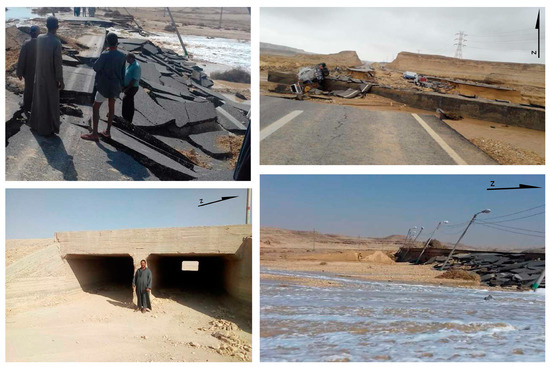
Figure 1.
Photographs show the destruction of El Geish highway by the March 2020 flash flood. Source: https://www.youm7.com (Online Newspaper published on 14 March 2020).
The Geographic Information System (GIS) is an important technique that provides the capacity to design geospatial identities and analyze and manipulate spatial information. This information can be managed and organized through attribute tables. The tabulated data is linked to the geographic features, which may contain multiple quantitative and qualitative information.
GIS-based AHP calculations are very important in revealing spatial trends and relationships between geospatial data and retrieving valuable information for decision-making [5]. Multi-criteria decision analysis (MCDA) is a decision-making technique developed to make solutions to complex decision problems [6]. The GIS-MCDA uses the analytical hierarchical process (AHP) method for controlling and arranging the parameters to investigate complex decisions [7]. The GIS-MCDA method has the ability to process and combine different types of geospatial data (rainfall map, land cover, soil types, slope map, drainage density); results can be visualized and presented in maps [5]. It is a very important spatial decision tool for spatial planning and management issues [8,9]. Integration of GIS and MCDA has been globally applied to assess flood hazards and risk assessment in Greece [6,10], Iran [7], Malaysia [11], Saudi Arabia [12], India [13], and Egypt [14].
2. Study Area
The Minya area is located about 240 km south of Cairo city, the capital of Egypt, on the crossing of Longitude 31°30′ N, Latitude 28° E. The drainage basin selected for study has two large valleys (Wadi al-Tarfah and Wadi al-Bustan) crossing the limestone plateau. The mouth of the basin is situated in eastern Beni Mazar city in northeastern Minya city. The area of study extends to cover most of the eastern part of Minya governorate; it covers an area of 10,682.9 sq. km, as shown in Figure 2.
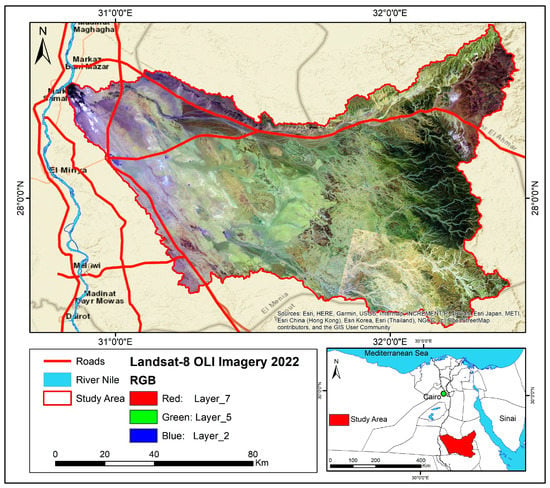
Figure 2.
Location map of study area.
3. Materials and Methods
Satellite remote sensing and GIS data were collected for this study to generate the flash flood hazard map based on the AHP technique, as shown in the flowchart in Figure 3. Six significant flood-controlling factors were selected based on the physical and natural properties of the study area, including elevations, slopes, soils, hydrology, land cover, geology, and rainfall. GIS-based MCDA has the ability to examine multi-criteria factors thematic maps using weighted overlaid analysis to assess the flash flood hazard map and risk along human activities [6,7].
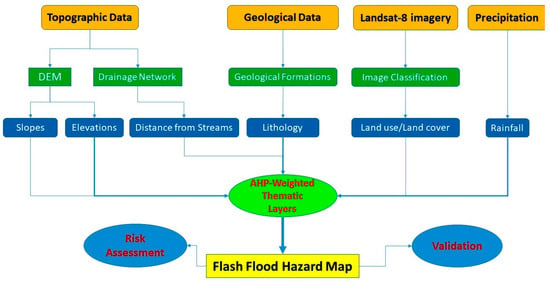
Figure 3.
Flowchart shows the MCDA method applied in this study.
The analytical hierarchy process (AHP) has been applied in this study to assess the flash flood hazard and risk in the watershed of the study area; spatial criteria used in this study come from geology, topography, rainfall, hydrology, soil, and land cover maps.
3.1. Lithological Data
The Egyptian geological map of the study area scale 1:500,000 was digitized and analyzed to identify the lithological units, and three major geological formations were detected: (1) Quaternary deposits occupy 13.3% of study area, including sand sheets, wadi deposits, and gravels. (2) The Eocene limestone formation is covering 82.4% of the study area, including the Samalut, Minia, Maghagha, Observatory, Qarara, and Thebos Formations. In addition, (3) the Cretaceous formations cover 4.3% of study area, which include Rakhiyat, Galala, Sudr, Umm Omeiyed, Hawashiya, and Wadi Qena Formations, as shown in Figure 4. Geology is one of the main factors effecting in runoff due to the permeability of rocks and faults may increase the infiltration rate.
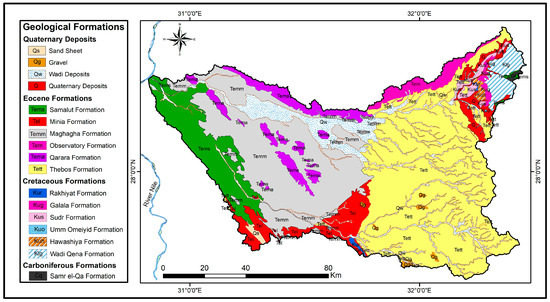
Figure 4.
Geological formations of study area.
3.2. Topography
Topographic analysis is a significant factor for flash flood hazard and risk assessment. Satellite-based Digital Elevation Models (DEMs), including SRTM-1arc second (30 m spatial resolution), were downloaded and processed to extract elevations, contours, slopes, aspects, and hydrological analyses shown in Figure 5a–c.
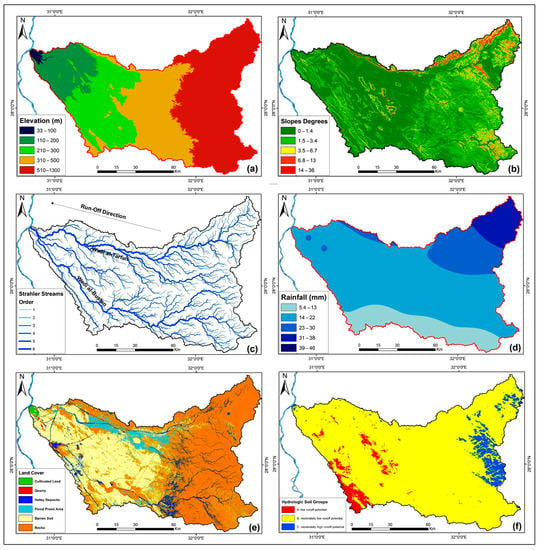
Figure 5.
Multi-criteria applied in this study. (a) Elevation (m); (b) Slopes Degrees; (c) Streams; (d) Rainfall from 2010 to 2020 in mm; (e) Land use/Land cover in 2020; (f) Hydrological Soil Group based HYSOGs250m.
3.3. Watershed Delineation
Hydrology is considered the main effective factor in flash flood intensity and its risk. The ArcGIS-based spatial modeler is used to delineate and map stream orders, flow accumulation, flow direction, and watersheds using the Strahler equation. The drainage basins that have been selected for study contain two large valleys, as shown in Figure 5e.
3.4. Rainfall (mm)
The climate is one of the most important factors which directly affects the intensity of flash floods and run-off processes. Satellite-based rainfall data of this study area were collected and analyzed from 2015 to 2020 (https://power.larc.nasa.gov/data-access-viewer/ (accessed on 5 February 2023)). Figure 5d shows a spatial surface estimation of the rainfall data using the IDW interpolation method.
3.5. Land Use/Land Cover (LU/LC)
Landsat-8 OLI imagery taken in 2022 was downloaded from the USGS website: https://earthexplorer.usgs.gov/ (accessed on 28 January 2023). Preprocessing was done, and then unsupervised classification algorithms were used to map the land use/cover classes for the study area. This map is significant for flood hazard and risk assessment.
3.6. Hydrological Soil Group (HYSOGs250m)
The global hydrological soil group data were downloaded from the website: https://daac.ornl.gov/SOILS/guides/Global_Hydrologic_Soil_Group.html (accessed on 7 February 2023) to identify the geographic distribution map of soils inside the study area; three different soil categories were detected in the study area as shown in Figure 5f.
4. Results and Discussion
Eight selected spatial criteria that applied in this study have been reclassified to hazard degrees for each factor separately from (1 to 5 values) (very low to very high), respectively, as shown in Figure 6.
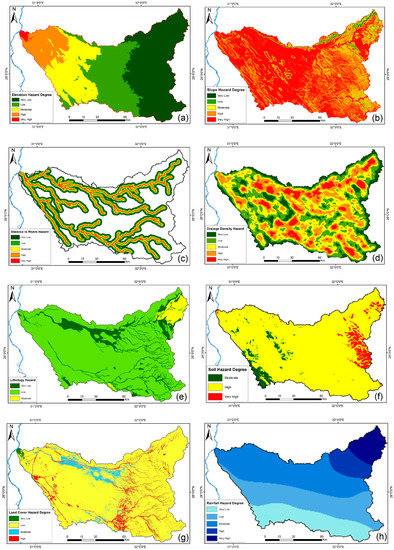
Figure 6.
Spatial Multi-Criteria Hazard Zonation. (a) Elevation; (b) Slopes; (c) Distance from Rivers; (d) Drainage Density; (e) Lithology; (f) Soil Hazard; (g) Land Cover Hazard; and (h) Rainfall.
4.1. Topographic Hazard Zonation
Five hazard degrees were assigned for topography; the lowest elevation land considers a higher rate of flash flood than the highest elevated area.
4.2. Slopes Hazard Zonation
The slope degrees are a topographic factor that refers to the flow speed of the rainfall-runoff water. The areas with fewer slope degrees are considered at risk of flood and inundation than the steep slope cliffs.
4.3. Distances from Wadis (Rivers) Zonation
The surrounding land of the channels is much more prone to effect by floodwater. In this study, the 3rd, 4th, 5th, and 6th stream orders are considered the main channels that are filled by water during floods. A 200 m buffer zone is considered a very high-risk zone, while the land far from 1000 m from the main channels is a safe area.
4.4. Drainage Density Hazard Zonation
It is a hydrological factor that refers to the number of streams in the study area. GIS is capable of calculating the line density of streams in the sq. km. Areas with a higher density are considered more at risk than lower-density areas.
4.5. The Permeability Hazard Map
The study area has different geological formations, and the quaternary deposits are considered permeable land (low-risk area), while the Eocene limestone formations were considered a semi-permeable zone (moderate risk). The carboniferous formation is much older and considered an impermeable zone (high risk).
4.6. The Soil Group Hazard Zonation
Three soil groups were selected. Group (A) is considered the lowest hazard zone because it refers to sand-deep sandy soils with very high intrusion rates. Group (B) is a moderate hazard zone because it has relatively fine grains of soil with moderate intrusion rates. Moreover, group (C) is considered the highest hazard degree zone in this study area because it shows fine grains of soil with low intrusion rates.
4.7. Land Use/Land Cover Hazard Map
The classification of satellite imagery of the study area produced several classes of land cover categories. The classes of dry valleys, Wadi paths, and flood-prone areas are considered the highest-risk areas, while the cultivated land is less risky.
4.8. The Precipitation Hazard Map
Rainfall data density was classified into five hazard zones according to the amount of rainfall (mm). The higher rainfall area is assigned as a higher risk area.
4.9. AHP Weighted Overlay Calculation
Multi-criteria decision-making analysis techniques include using the analytical hierarchy process analysis, which links multi-spatial data on the same scale. To apply these techniques, weighted overly modeling was used to calculate the weight of each factor and link all factors together using mathematical equations. Table 1. shows a pairwise comparison matrix for factor criteria (selected eight factors). In addition, the percentage of importance criteria values calculated in this study is shown in Table 2.

Table 1.
Pairwise comparison matrix for factor criteria.

Table 2.
Percentage values of importance using the analytic hierarchy process (AHP).
The resulting map from this study is presented in Figure 7. Three different hazard and risk zones were identified using the previous criteria. The higher hazard degree zone was displayed in the red color in the downstream run-off water. The main highway of Elgeish Road and Minia–Ras Ghareb highway, as well as the cultivated land along the fluvial fans, will be seriously affected by the downstream water. The moderate hazard zone covers a larger area surrounded by human activities.
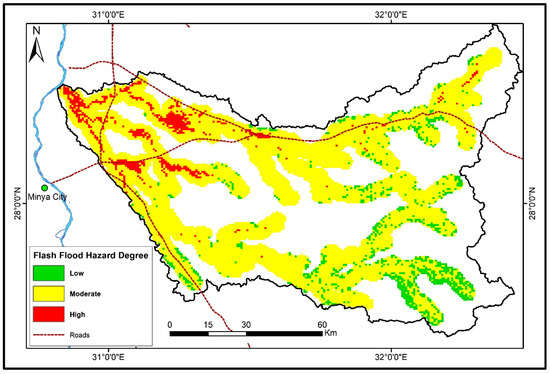
Figure 7.
Flash flood hazard map based on MCDA.
5. Conclusions
This study applied the multi-criteria decision-making analysis approach in Geographic Information Systems. It was used in several studies around the world and recommended for flash flood hazard and risk mapping. There are no previous studies that applied this technique for assessing flash floods in this study area. This technique is considered the most effective because it has the ability to link multi-sources spatial data at the same scale to detect the best geospatial solution for decision-makers. In this study, the available criteria were used and combined in the weighted overly modeling in GIS to map the vulnerable areas with a flash flood in a watershed basin in Middle Egypt. The results of this study show a higher flood zone in the downstream area; this area is occupied by highways, cultivated lands, and human settlements. It is highly recommended to use MCDA-based AHP techniques for flash flood hazard and risk mapping in future studies.
Funding
This research received no external funding.
Institutional Review Board Statement
Not applicable.
Informed Consent Statement
Not applicable.
Data Availability Statement
All the data of the study are presented in the paper.
Conflicts of Interest
The author declares no conflict of interest.
References
- WMO. World Meteorological Organization: Flash Flood Guidance System (FFGS) with Global Coverage. 2016. Available online: https://community.wmo.int/hydrology-and-water-resources/flash-flood-guidance-system-ffgs-global-coverage (accessed on 27 January 2023).
- El Gohary, R. Environmental Flash Flood Management in Egypt. In Flash Floods in Egypt; Negm, E.E., Ed.; Advances in Science, Technology & Innovation; Springer: New York, NY, USA, 2020; pp. 85–105. [Google Scholar]
- Elnazer, A.A.; Salman, S.A.; Asmoay, A.S. Flash flood hazard affected Ras Gharib city, Red Sea, Egypt: A proposed flash flood channel. Nat. Haz. 2017, 89, 1389–1400. [Google Scholar] [CrossRef]
- El-Saadawy, O.; Gaber, A.; Othman, A.; Abotalib, A.Z.; El Bastawesy, M.; Attwa, M. Modeling Flash Floods and Induced Recharge into Alluvial Aquifers Using Multi-Temporal Remote Sensing and Electrical Resistivity Imaging. Sustainability 2020, 12, 10204. [Google Scholar] [CrossRef]
- Awange, J.; Kiema, J. Fundamentals of GIS. In Environmental Geoinformatics. Environmental Science and Engineering, 2nd ed.; Springer: Cham, Switzerland, 2019; pp. 203–212. [Google Scholar]
- Karymbalis, E.; Andreou, M.; Batzakis, D.-V.; Tsanakas, K.; Karalis, S. Integration of GIS-Based Multicriteria Decision Analysis and Analytic Hierarchy Process for Flood-Hazard Assessment in the Megalo Rema River Catchment (East Attica, Greece). Sustainability 2021, 13, 10232. [Google Scholar] [CrossRef]
- Allafta, H.; Opp, C. GIS-based multi-criteria analysis for flood prone areas mapping in the trans-boundary Shatt Al-Arab basin, Iraq-Iran. Geomat. Nat. Hazards Risk 2021, 12, 2087–2116. [Google Scholar] [CrossRef]
- Malczewski, J. GIS-based multicriteria decision analysis: A survey of the literature. Int. J. Geogr. Inf. Sci. 2006, 20, 703–726. [Google Scholar] [CrossRef]
- Drobne, S.; Lisec, A. Multi-attribute Decision Analysis in GIS: Weighted Linear Combination and Ordered Weighted Averaging. Informatica 2009, 33, 459–474. [Google Scholar]
- Kazakis, N.; Kougias, I.; Patsialis, T. Assessment of flood hazard areas at a regional scale using an index-based approach and Analytical Hierarchy Process: Application in Rhodope-Evros region, Greece. Sci. Total Environ. 2015, 538, 555–563. [Google Scholar] [CrossRef] [PubMed]
- Elsheikh, R.F.A.; Ouerghi, S.; Elhag, A.R. Flood Risk Map Based on GIS, and Multi Criteria Techniques (Case Study Terengganu Malaysia). J. Geogr. Inf. Syst. 2015, 7, 348–357. [Google Scholar] [CrossRef]
- Abdelkarim, A.; Al-Alola, S.S.; Alogayell, H.M.; Mohamed, S.A.; Alkadi, I.I.; Ismail, I.Y. Integration of GIS-Based Multicriteria Decision Analysis and Analytic Hierarchy Process to Assess Flood Hazard on the Al-Shamal Train Pathway in Al-Qurayyat Region, Kingdom of Saudi Arabia. Water 2020, 12, 1702. [Google Scholar] [CrossRef]
- Das, S. Flood susceptibility mapping of the Western Ghat coastal belt using multi-source geospatial data and analytical hierarchy process (AHP). Remote Sens. Appl. Soc. Environ. 2020, 20, 100379. [Google Scholar] [CrossRef]
- Abu El-Magd, S.A.; Amer, R.A.; Embaby, A. Multi-criteria decision-making for the analysis of flash floods: A case study of Awlad Toq-Sherq, Southeast Sohag, Egypt. J. Afr. Earth Sci. 2020, 162, 103709. [Google Scholar] [CrossRef]
Disclaimer/Publisher’s Note: The statements, opinions and data contained in all publications are solely those of the individual author(s) and contributor(s) and not of MDPI and/or the editor(s). MDPI and/or the editor(s) disclaim responsibility for any injury to people or property resulting from any ideas, methods, instructions or products referred to in the content. |
© 2023 by the author. Licensee MDPI, Basel, Switzerland. This article is an open access article distributed under the terms and conditions of the Creative Commons Attribution (CC BY) license (https://creativecommons.org/licenses/by/4.0/).